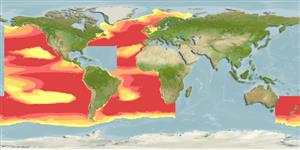Teleostei (teleosts) >
Anguilliformes (Eels and morays) >
Derichthyidae (Longneck eels)
Etymology: Derichthys: Greek, deras, -atos = skin + Greek, ichthys = fish (Ref. 45335).
More on author: Gill.
Environment: milieu / climate zone / depth range / distribution range
Ecology
Marine; bathypelagic; depth range 0 - 2000 m (Ref. 35591), usually 200 - 700 m (Ref. 58302). Deep-water
Circumglobal: In tropical to temperate waters. Eastern Atlantic: one confirmed record near Ascension Islands. Eastern Pacific: southern California to Chile (Ref. 35591).
Size / Weight / Age
Maturity: Lm ? range ? - ? cm
Max length : 40.0 cm TL male/unsexed; (Ref. 6592)
Meso- to bathypelagic (Ref. 58302). Feed on small fishes and crustaceans. Eggs and leptocephali are planktonic (Ref. 35591). Minimum depth from Ref. 58018.
Life cycle and mating behavior
Maturities | Reproduction | Spawnings | Egg(s) | Fecundities | Larvae
Smith, D.G., 1990. Derichthyidae. p. 193-194. In J.C. Quero, J.C. Hureau, C. Karrer, A. Post and L. Saldanha (eds.) Check-list of the fishes of the eastern tropical Atlantic (CLOFETA). JNICT, Lisbon; SEI, Paris; and UNESCO, Paris. Vol. 1. (Ref. 5228)
IUCN Red List Status (Ref. 130435)
Threat to humans
Harmless
Human uses
Fisheries: of no interest
Tools
Special reports
Download XML
Internet sources
Estimates based on models
Preferred temperature (Ref.
123201): 3.5 - 13.5, mean 7.8 °C (based on 805 cells).
Phylogenetic diversity index (Ref.
82804): PD
50 = 1.1250 [Uniqueness, from 0.5 = low to 2.0 = high].
Bayesian length-weight: a=0.00102 (0.00046 - 0.00225), b=3.06 (2.88 - 3.24), in cm total length, based on all LWR estimates for this body shape (Ref.
93245).
Trophic level (Ref.
69278): 3.1 ±0.30 se; based on food items.
Fishing Vulnerability (Ref.
59153): Low to moderate vulnerability (30 of 100).
